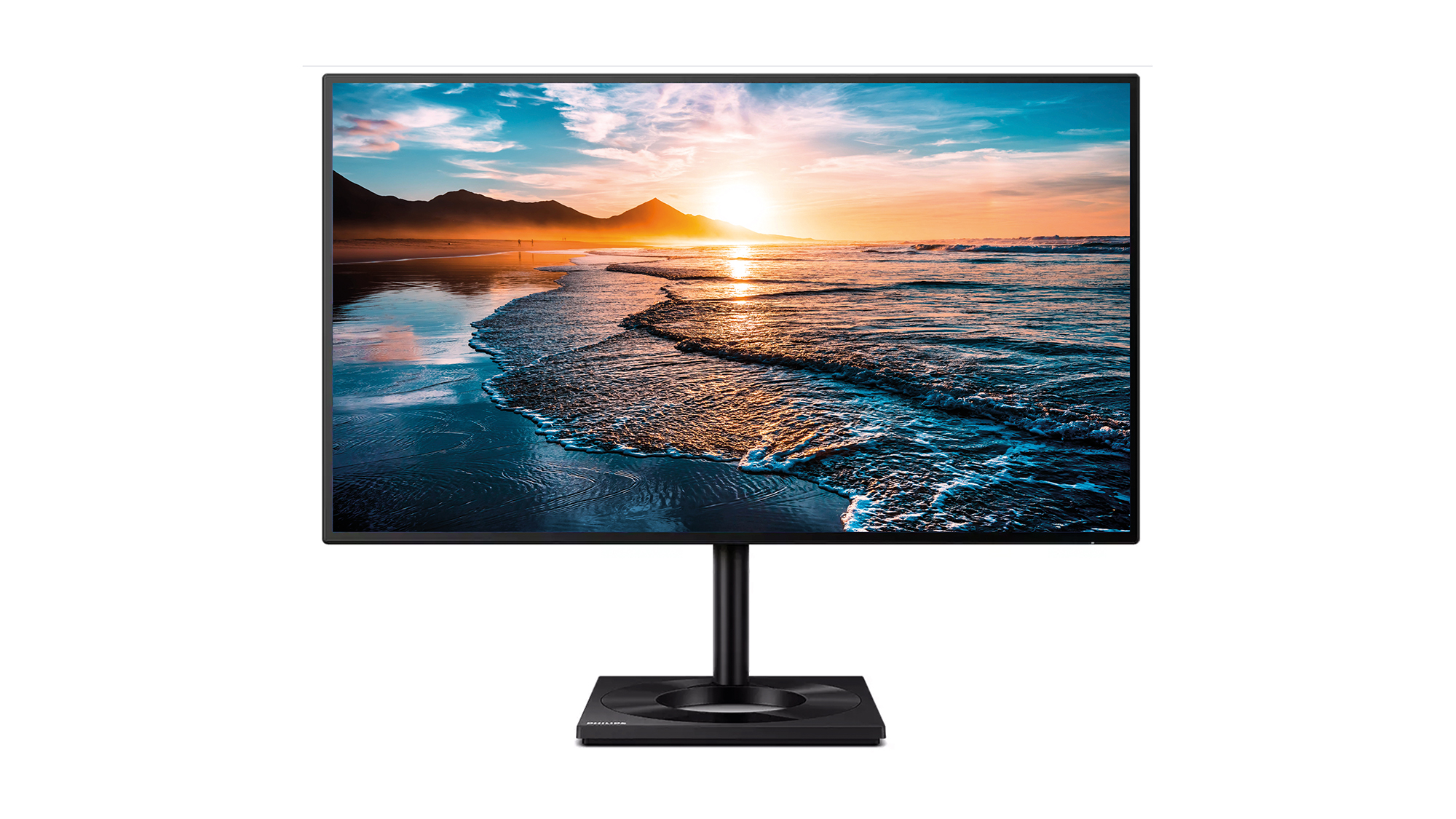Philips Moda 27 (4K) review: Moda, Moda, burning bright
You don’t have to pay nearly £500 for 4K, but the Moda 27 might just tempt you


-
+
Stylish design
-
+
Outstanding colour accuracy
-
+
Slick OSD
-
-
Expensive

The Iiyama ProLite XU2792UHSU-B1 aptly demonstrated that there’s no need to spend almost £500 to buy a 27in 4K monitor, so the question you may be asking yourself is what makes the Philips Moda 27 worth its rather weighty pricetag, compared to cheaper alternatives.
Philips plays the style card with the Moda 27, with an art deco feel to the square base and its cut-out circle. The metal pole is finished in a tasteful matte grey, but don’t think this stand lacks for features: you can adjust the height by up to 130mm, pivot the screen 90° and rotate it through 350°. Some top engineering work has gone on here. The only potential hiccup is cable management: there’s a tidy at the rear of the pole, but if you want to avoid trailing wires you’ll need to get creative with cable ties.
The primary reason, however, is the quality of the panel, which sailed through our technical tests. Put into sRGB mode, where our sample locked to a brightness of 279cd/m2, it covered 93.6% of the gamut out of 93.9% volume (which means there’s no overspill) with an average Delta E of 0.54 and a maximum of 1.03. These are stellar results that are up there with some of the best units in its class. Combine that with a 1,304:1 contrast ratio and spot-on 6522K colour temperature and you have a screen that’s exceptionally easy on the eye.
On top of that, an intuitive OSD, controlled via a joystick, allows you to quickly switch into one of Philips’ multitude of “smart” presets, and these are worth experimenting with. For instance, the Office mode (as the name implies) is great for general work. Another benefit of these modes is that you can push the screen up to its full brightness, reaching 382cd/m2 in Photo mode, for example.
The other key advantage of the Moda over the other 4K screens like the Iiyama is that it includes a USB-C input, delivering 65W of power. Bearing in mind there’s an external power supply, we hoped for greater output so that more power-hungry devices like MacBook Pros, for example, could be charged, but 65W is enough for most laptops. It’s good to see four USB-A 3.2 ports here too, even if they’re all tucked away at the rear. Finally, note the three other video inputs: two HDMI 2.0 and one DisplayPort 1.4. That’s a solid selection of connectors.
Bearing in mind all the quality on show, the price feels eminently reasonable (if you see a Philips Moda 27 for around £300, note that’s for an older model that includes a 1440p panel). Like a Netflix space documentary played over HDMI to take advantage of the Moda’s DisplayHDR 400 certification, this is a monitor that shines bright.
Philips Moda 27 (4K) specifications
| Screen size | 27in |
| Screen resolution | 3,840 x 2,160 |
| Screen technology | IPS |
| Screen refresh rate | 75Hz |
| Video inputs | 1x DisplayPort 1.4, 2x HDMI 2.0, 1x USB-C (65W) |
| Audio inputs/outputs | 3.5mm headphone socket |
| Speakers | N/A |
| Ports | 4x USB-A 3.2 |
| Adjustability | 130mm height adjustment, portrait mode, -5°/+20° tilt, 350° swivel |
| Dimensions | 611 x 185 x 397-527mm |
| Weight | 5.9kg |
| Warranty | 2yr RTB |
Sign up today and you will receive a free copy of our Future Focus 2025 report - the leading guidance on AI, cybersecurity and other IT challenges as per 700+ senior executives
Tim Danton is editor-in-chief of PC Pro, the UK's biggest selling IT monthly magazine. He specialises in reviews of laptops, desktop PCs and monitors, and is also author of a book called The Computers That Made Britain.
You can contact Tim directly at editor@pcpro.co.uk.
-
 ‘1 engineer, 1 month, 1 million lines of code’: Microsoft wants to replace C and C++ code with Rust by 2030 – but a senior engineer insists the company has no plans on using AI to rewrite Windows source code
‘1 engineer, 1 month, 1 million lines of code’: Microsoft wants to replace C and C++ code with Rust by 2030 – but a senior engineer insists the company has no plans on using AI to rewrite Windows source codeNews Windows won’t be rewritten in Rust using AI, according to a senior Microsoft engineer, but the company still has bold plans for embracing the popular programming language
By Ross Kelly Published
-
 Google drops $4.75bn on data center and energy firm Intersect
Google drops $4.75bn on data center and energy firm IntersectNews The investment marks the latest move from Google to boost its infrastructure sustainability credentials
By Nicole Kobie Published
-
 OpenAI says prompt injection attacks are a serious threat for AI browsers – and it’s a problem that’s ‘unlikely to ever be fully solved'
OpenAI says prompt injection attacks are a serious threat for AI browsers – and it’s a problem that’s ‘unlikely to ever be fully solved'News OpenAI details efforts to protect ChatGPT Atlas against prompt injection attacks
By Nicole Kobie Published
